Heybeliada - Center
- Details
- Created on 18 February 2013
- Last Updated on 11 April 2013
Village Center
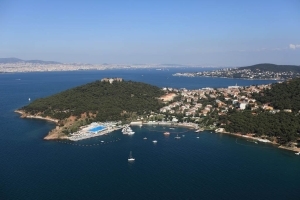 As the visitor approaches the island by ferry he can observe the Greek Orthodox seminary dominating its hill, the Halki Palas Hotel, the former Greek Commercial School (now part of the Naval High School), and the old windmill topping Değirmen Tepesi, above the Water Sports Club.
As the visitor approaches the island by ferry he can observe the Greek Orthodox seminary dominating its hill, the Halki Palas Hotel, the former Greek Commercial School (now part of the Naval High School), and the old windmill topping Değirmen Tepesi, above the Water Sports Club.
The focal point of the village is the ferry landing on the east coast, with the iskele for the sea bus a short distance to its north. The shore road betwen the two iskeles is lined with cafes and restaurants. The principal market street runs parallel to the shore road one short block in from the sea. On the southeastern promontory of the island, next to the ferry landing, is the Deniz Lisesi or Naval High School, with its twin-towered main building and miniature port, and just north of the iskeles is a little fishing port, in which fishing boats and pleasure craft are anchored.
The Greek Orthodox Church of St. Nicholas
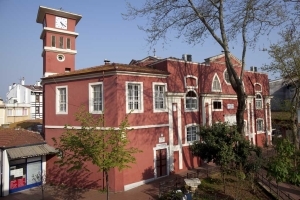 The Greek Orthodox church of St. Nicholas (Hagios Nikolaos) dominates the main square of the village, two short blocks in from the sea bus iskele. It was erected in 1857 on the ruins of a Byzantine church dedicated to St. Nicholas, the patron saint of mariners, appropriate for an island where virtually all of the men were seafarers and fishermen. The architect was Hacı Stefani Gaytanki Kalfa. The church was damaged in the 1894 earthquake, but it was soon afterwards repaired. It is cruciform in plan, with a dome on a high drum covering the central area, supported by four piers, and with barrel vaults over the four arms, a lofty clock-tower campanile rising separately from the main structure. Behind the altar is the tomb of Patriarch Samuel I, who died in 1775. A separate building in front of the narthex houses the hagiasma, or sacred spring, of St. Paraskevi (Hagia Paraskevi).
The Greek Orthodox church of St. Nicholas (Hagios Nikolaos) dominates the main square of the village, two short blocks in from the sea bus iskele. It was erected in 1857 on the ruins of a Byzantine church dedicated to St. Nicholas, the patron saint of mariners, appropriate for an island where virtually all of the men were seafarers and fishermen. The architect was Hacı Stefani Gaytanki Kalfa. The church was damaged in the 1894 earthquake, but it was soon afterwards repaired. It is cruciform in plan, with a dome on a high drum covering the central area, supported by four piers, and with barrel vaults over the four arms, a lofty clock-tower campanile rising separately from the main structure. Behind the altar is the tomb of Patriarch Samuel I, who died in 1775. A separate building in front of the narthex houses the hagiasma, or sacred spring, of St. Paraskevi (Hagia Paraskevi).
The Ben Yazkor Synagogue
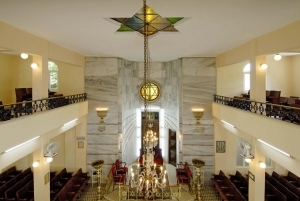 The Ben Yazkor Synagogue is on Orhon Sokaği in the Kuyu Mahalle, north of the village center. The former Greek Primary School is close by on Heybeli Mektebi Sokağı. The mosque, Heybeliada Camii, is on Hafız Kaptan Sokağı at the northwest side of the village.
The Ben Yazkor Synagogue is on Orhon Sokaği in the Kuyu Mahalle, north of the village center. The former Greek Primary School is close by on Heybeli Mektebi Sokağı. The mosque, Heybeliada Camii, is on Hafız Kaptan Sokağı at the northwest side of the village.
The Naval High School
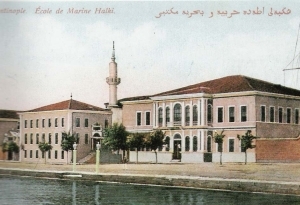 The Naval High School was founded in 1773 as the Mektebi Bahriye and moved to Heybeliada in the mid-nineteenth century. After the founding of the Turkish Republic in 1923 the school was renamed the Naval War Academy (Deniz Harb Okulu). When the Naval War Academy was moved to Tuzla in 1985 the school on Heybeliada became the Naval High School (Deniz Lisesi). Among the foreign heads of state who were received here were King Paul of Greece (1952), Marshal Tito of Yugoslavia (1954), Shah Riza Pahlavi of Iran (1976), and Prime Minister Zülfikar Ali Bhutto of Pakistan (1976), all of whom arrived aboard the Savarona, Atatürk’s presidential yacht.
The Naval High School was founded in 1773 as the Mektebi Bahriye and moved to Heybeliada in the mid-nineteenth century. After the founding of the Turkish Republic in 1923 the school was renamed the Naval War Academy (Deniz Harb Okulu). When the Naval War Academy was moved to Tuzla in 1985 the school on Heybeliada became the Naval High School (Deniz Lisesi). Among the foreign heads of state who were received here were King Paul of Greece (1952), Marshal Tito of Yugoslavia (1954), Shah Riza Pahlavi of Iran (1976), and Prime Minister Zülfikar Ali Bhutto of Pakistan (1976), all of whom arrived aboard the Savarona, Atatürk’s presidential yacht.
Statue of Yesari Asim Arsoy
In a little park next to the Naval High School there is a statue of Yesari Asim Arsoy (1896-1992), famous as the composer of a song celebrating Heybeli (see below in the description of Çam Limanı).
Iliasko Ikiz Evleri
Iliasko Ikiz Evleri on the other side of the coach stop. Formerly the Hotel de la Grèce; guests included King Paul of Greece in 1921 and Greek Prime Minister Elefterios Venizelos in 1933.
Rum İlkokulu

Heybeliada Çeşmesi
The large marble street-fountain on Turgut Yolu is the Heybeliada Çeşmesi, built in 1917.
Museum of İsmet İnönü
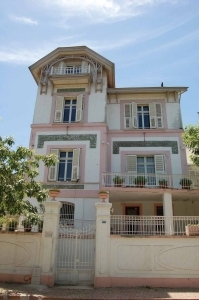 The mansion at #73 Refah Şehitleri Caddesi, originally known as the Mavromatakis Köşkü, is now open as a museum belonging to the Inönü Foundation, which is operated by the family of Ismet Inönü, first Turkish Prime Minister and later President of the Turkish Republic. Ismet Inönü, known as Ismet Paşa, first rented the house as a summer home in 1924, when he recuperated there after an illness. The Inönüs bought the house in 1934 for 9,500 liras, with new furniture presented to them as a gift by Atatürk. In September 1937, after leaving political office, Ismet Paşa settled into the house, where later that same year he was visited by the newly appointed Prime Minister Celal Bayar. During the years 1938-50, when he served as President of the Turkish Republic, Ismet Paşa stayed in the official summer residences at Florya and Yalova, because of the number of officials who made up his entourage, while his wife, Mevhibe Hanım, preferred to spend most of the summers in the house on Heybeli with their children, Ömer, Erdal, and Özden. During the years 1950-60, when Ismet Paşa was the leader of the opposition party, he spent most of the summers with his family on Heybeliada, where in his daily excursions to the beach he was accompanied by many of the townspeople, with the younger ones joining him as he jumped into the sea feet first from the pier. During his next term as Prime Minister, 1961-65, he still went to Heybeliada whenever his schedule allowed, and after leaving office he again spent his summers there. After his death in Ankara on 25 December 1973, at the age of eighty-nine, the house on Heybeli remained closed for a few years, but later Mevhibe Hanım occasionally returned along with her son Erdal and his wife, Sevinç, who had spent her summers in a neighboring house. Eventually the family decided to have the house preserved as a museum under the Inönü Foundation, restored just as it was when Ismet Paşa moved there in 1937, with the furniture presented to him by Atatürk. Here the visitor can see a variety of objects, pictures, and personal mementos of Ismet Paşa’s public and family life.
The mansion at #73 Refah Şehitleri Caddesi, originally known as the Mavromatakis Köşkü, is now open as a museum belonging to the Inönü Foundation, which is operated by the family of Ismet Inönü, first Turkish Prime Minister and later President of the Turkish Republic. Ismet Inönü, known as Ismet Paşa, first rented the house as a summer home in 1924, when he recuperated there after an illness. The Inönüs bought the house in 1934 for 9,500 liras, with new furniture presented to them as a gift by Atatürk. In September 1937, after leaving political office, Ismet Paşa settled into the house, where later that same year he was visited by the newly appointed Prime Minister Celal Bayar. During the years 1938-50, when he served as President of the Turkish Republic, Ismet Paşa stayed in the official summer residences at Florya and Yalova, because of the number of officials who made up his entourage, while his wife, Mevhibe Hanım, preferred to spend most of the summers in the house on Heybeli with their children, Ömer, Erdal, and Özden. During the years 1950-60, when Ismet Paşa was the leader of the opposition party, he spent most of the summers with his family on Heybeliada, where in his daily excursions to the beach he was accompanied by many of the townspeople, with the younger ones joining him as he jumped into the sea feet first from the pier. During his next term as Prime Minister, 1961-65, he still went to Heybeliada whenever his schedule allowed, and after leaving office he again spent his summers there. After his death in Ankara on 25 December 1973, at the age of eighty-nine, the house on Heybeli remained closed for a few years, but later Mevhibe Hanım occasionally returned along with her son Erdal and his wife, Sevinç, who had spent her summers in a neighboring house. Eventually the family decided to have the house preserved as a museum under the Inönü Foundation, restored just as it was when Ismet Paşa moved there in 1937, with the furniture presented to him by Atatürk. Here the visitor can see a variety of objects, pictures, and personal mementos of Ismet Paşa’s public and family life.


 Transportation
Transportation 